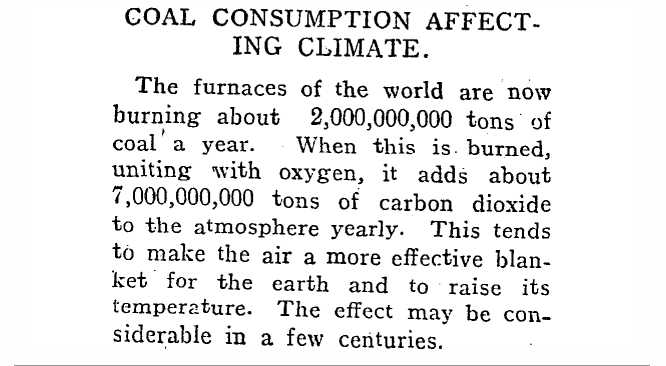News Clip Linked Coal to Climate Change — 106 Years Ago Today

A note published in a New Zealand paper 106 years ago today (Aug. 14) predicted the Earth's temperature would rise because of 7 billion tons of carbon dioxide produced by coal consumption.
"The effect may be considerable in a few centuries," the article stated.
The clip was one of several one-paragraph stories in the "Science Notes and News" section of The Rodney and Otamatea Times, published Wednesday, Aug. 14, 1912.
The paragraph seems to have been originally printed in the March 1912 issue of Popular Mechanics as the caption for an image of a large coal factory. The image goes with a story titled "Remarkable Weather of 1911: The Effect of the Combustion of Coal on the Climate — What Scientists Predict for the Future," by Francis Molena. [Photographic Proof of Climate Change: Time-Lapse Images of Retreating Glaciers]
In the article, Molena described how carbon dioxide in the air is associated with warmer temperatures, and "since burning coal produces carbon dioxide, it may be inquired whether the enormous use of that fuel in modern times may be an important factor in filling the atmosphere with this substance, and consequently indirectly raising the temperature of the Earth."
When Molena's story was published, scientists had already been predicting the effects of coal combustion on climate for the past few decades. Researchers were studying the topic at least as early as 1882, as evidenced by H.A. Phillips' paper titled "Pollution of the Atmosphere," published that year in the journal Nature.
Jeff Nichols, a historian at the University of Illinois at Chicago, told Quartz that he's found many examples of newspaper articles published between 1883 and 1912 that make predictions about how rising carbon dioxide levels alter the climate. The New York Times, The Philadelphia Inquirer, and The Kansas City Star all published articles about rising carbon dioxide levels affecting the climate more than a hundred years ago, Quartz reported.
Sign up for the Live Science daily newsletter now
Get the world’s most fascinating discoveries delivered straight to your inbox.
Carbon dioxide continues to make up 65 percent of global greenhouse gas emissions, having increased by 90 percent between 1900 and 2010, according to estimates from the Environmental Protection Agency (EPA). As of 2014, the top carbon dioxide-producing regions were China, the United States, the European Union, India, the Russian Federation and Japan, according to the EPA.
Original article on Live Science.

Kimberly has a bachelor's degree in marine biology from Texas A&M University, a master's degree in biology from Southeastern Louisiana University and a graduate certificate in science communication from the University of California, Santa Cruz. She is a former reference editor for Live Science and Space.com. Her work has appeared in Inside Science, News from Science, the San Jose Mercury and others. Her favorite stories include those about animals and obscurities. A Texas native, Kim now lives in a California redwood forest.










